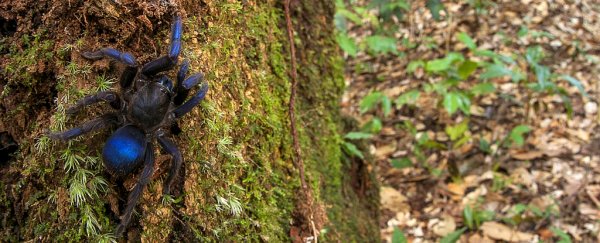A previously unknown tarantula discovered in the forests of Guyana in South America is absolutely stunning - its legs and body are a shimmering electric disco blue.
The find, according to the tarantula's discoverer Andrew Snyder, is an important one, and not just because it's such an unusual example of the Theraphosidae family. It highlights the importance of invertebrate conservation and the forests in which it dwells.
The discovery of the tarantula is just one of a haul of dozens of previously unknown species uncovered during a survey of the Kaieteur National Park and the Upper Potaro River.
If you follow natural science, you will know that we find previously unknown species on a fairly regular basis - certainly enough for an annual top 10 new species list.
But the WWF and Global Wildlife Conservation's Biodiversity Survey Team has announced a rarity - over 30 newly discovered species in one area.
The scientists have found a bonanza of flora and fauna, including three plants, a crab, a shrimp, a frog, several dragonflies and several water beetles.
As these things often go, Snyder discovered the tarantula almost by accident.
"During this particular night, my light beam reflected back with a small glint of brilliant, cobalt blue sticking out of a small hole in a rotting stump," he said.
"At first I quickly dismissed it - surely it was just the eye shine coming from a spider. But something was different, and I must have been subconsciously aware. Something made me go back."
The blue reflection turned out not to be eyes at all, but an iridescent blue shine reflected in flashlight off the legs of a small tarantula.
"I immediately knew that this one was unlike any species I have encountered before," Snyder said.
That's not necessarily because of the iridescence. The cobalt tarantula of southeast Asia has shimmery blue legs, as does the Singapore blue tarantula, and the greenbottle blue tarantula has blue legs and carapace.
As an interesting aside, in 2015 researchers found that there are multiple tarantulas with blue colouring, and they all evolved it using different mechanisms. It's probably not sexually selected - which suggests there's a good reason for it, we just don't know what it is.
On closer examination of the tree stump, Snyder found several other holes, each of which contained a tarantula - suggesting a possibility that the species is communal.
Early analysis based only on the photographs Snyder was able to obtain suggests it may belong to the subfamily Ischnocolinae, of which some species are indeed communal.
More research will need to be conducted to accurately classify the species and learn more about its habits, but in the meantime, Snyder hopes it can help highlight the importance of invertebrate conservation in Guyana.
Gold mining threatens many species in Guyana, not just because of land clearing, but also because of environmental contamination from the use of mercury, which is used to separate gold from other metals.
The biodiversity survey provides a wildlife assessment that may assist in designing practices to maintain habitats and animal life.
"This upland region where the surveys took place represents a very important transition zone for species between the lowlands and the highlands and was characterised by high levels of endemism for many taxonomic groups," Snyder said.
"This rapid inventory was able to provide an important glimpse into this special area and habitats, though more work is necessary to shed light on all of the region's secrets."
The report can be downloaded from the WWF website.
